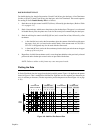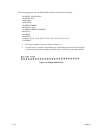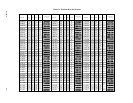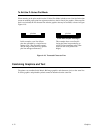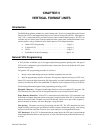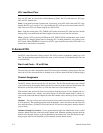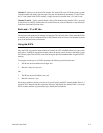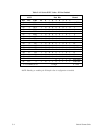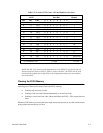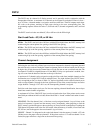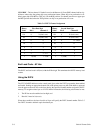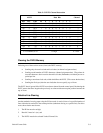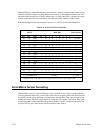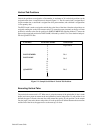
5–5Vertical Format Units
T
able 5–2. P–Series EVFU Codes – PI Line Disabled or Not Used
Hex
10
11
12
13
14
15
16
17
18
19
1A
1B
1C
1D
1E
1F
765 4 3 21
0
0
0
0
0
0
0
0
0
0
0
0
1
1
1
1
1
1
1
1
0
0
0
0
1
1
1
1
0
0
0
0
1
1
1
1
0
0
1
1
0
0
1
1
0
0
1
1
0
0
1
1
0
1
0
1
0
1
0
1
0
1
0
1
0
1
0
1
1 (TOF)
2
3
4
5
6
7
8
9
10
11
12 (VT)
13
14
Start Load
End Load
Dec
16
17
18
19
20
21
22
23
24
25
26
27
28
29
30
31
1
1
1
1
1
1
1
1
1
1
1
1
1
1
1
1
X = Undefined, 0 or 1
1 = High
0 = Low
ASCII ChannelData Bits
8
0
0
0
0
0
0
0
0
0
0
0
0
0
0
0
0
0
0
0
0
0
0
0
0
0
0
0
0
0
0
0
0
0
0
0
0
0
0
0
0
0
0
0
0
Code
DLE
DC1
DC2
DC3
DC4
NAK
SYN
ETB
CAN
EM
SUB
ESC
FS
GS
RS
US
NOTE:
The ESC code cannot
be used simultaneously as the EVFU VT code and the Special
Function
Contr
ol Character (SFCC). If ESC is used as the SFCC, the EVFU must be used
with
the PI line enabled and set high. Refer to the
Configuration chapter for mor
e informa
-
tion
on the SFCC.
Clearing the EVFU Memory
Following one of these actions resets (clears) the EVFU memory.
• Sending only the start load code.
• Sending a start load code followed immediately by an end load code.
• Sending a second start load code, which reinitializes the EVFU. (This restarts the host
data.)
When
the EVFU memory is cleared, the forms length returns to the previously set value and the current
print position becomes the top–of–form.



